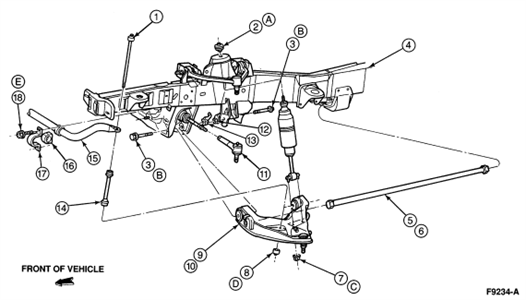Hello! First diagram is the lower...Second is the upper..Guru...saailer
LOWER IDENTIFICATION:
Item
Part Number
Description
1
5495
Stabilizer Bar Link Bolt and Bushing Assembly
2
18A192
Nut, Washer and Bushing Assembly
3
808264
Bolt
4
5005
Frame
5
5B326
Torsion Bar (LH)
6
5B327
Torsion Bar (RH)
7
620481
Nut
8
5C491
Nut and Washer
9
3079
Front Suspension Lower
Arm (LH)
10
3078
Front Suspension Lower
Arm (RH)
11
3A130
Tie Rod End
12
808166
Nut
13
808167
Nut
14
5K483
Front Stabilizer Bar Link
15
5482
Front Stabilizer Bar
16
5484
Front Stabilizer Bar Bushing
17
3B353
Front Stabilizer Retainer
18
N807396-S100
Bolt
A
-
Tighten to 40-55 Nm
(30-40 Lb-Ft)
B
-
Tighten to 150-200 Nm (111-148 Lb-Ft)
C
-
Tighten to 21-29 Nm
(15-21 Lb-Ft)
UPPER IDENTIFICATION:
Item
Part Number
Description
1
3C156
Damper Assembly (RH)
2
805348
Nut and Washer
3
-
Shock Absorber Insulator
(Part of 18198)
4
3C157
Damper Assembly (LH)
5
3020
Front Suspension Bumper
6
3083
Front Suspension Upper
Arm Assembly
A
-
Tighten to 34-47 Nm
(25-35 Lb-Ft)
LOWER DIAGRAM FOLLOWED BY UPPER:


I’m happy to help further over the phone at
https://www.6ya.com/expert/david_6df67de3b14de867




×